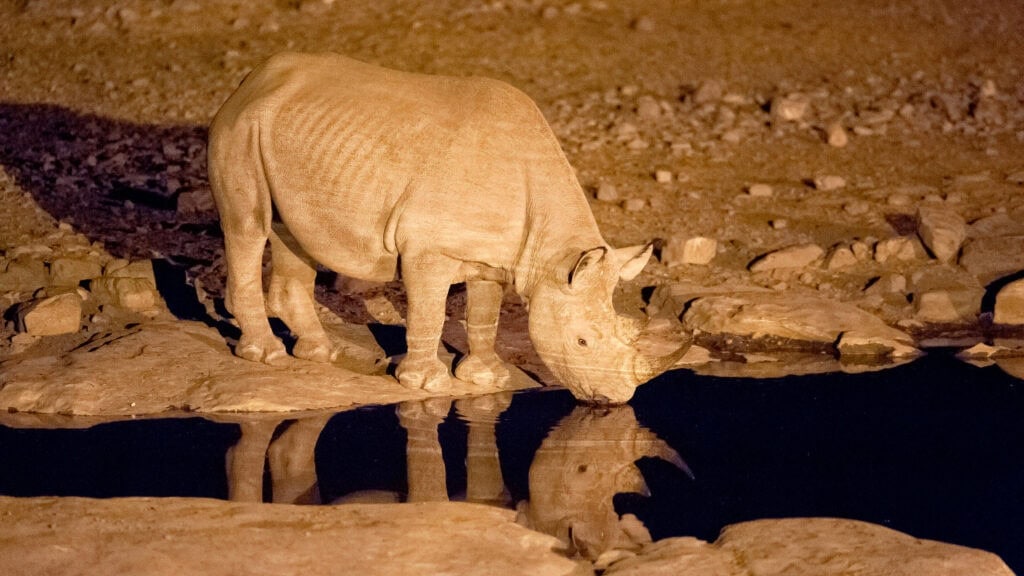Webcams at waterholes offer real-time, ‘live’ exposure to animals and their behaviours and interactions in Namibia. They highlight the dynamics of how an ecosystem functions, and offer a valuable educational tool for students, researchers and wildlife enthusiasts alike. But most of all, they offer the most extraordinary opportunities for people of all ages, persuasions and geographical locations, often vast distances apart, to share the most rewarding wildlife experiences.

People get to see a huge variety of animals going about their normal routines of drinking, interacting with each other and swimming. Elephants, in particular, are famous for their rowdy ‘pool parties’! This way of observing wildlife is completely non-intrusive and doesn’t impact the animals’ behaviour at all, ensuring a completely authentic viewing experience. Another very positive effect of these live feeds is that they inspire viewers to support conservation efforts. It likewise fosters a greater appreciation and knowledge of nature.
Namibia has several of these amazing webcams:
1. Okaukuejo Waterhole Webcams
Location: Okaukuejo waterhole is located in the Okaukuejo Rest Camp on the western edge of the Etosha Salt Pan, in Etosha National Park.
Info: Located in the arid desert environments of Namibia, the Okaukuejo waterhole is a lifeline to multitudes of animals. It therefore teems with life all year round, and it’s one of the best places to catch sight of Africa’s solitary and endangered black rhinos. Large numbers of elephants, zebras, kudus, oryx (gemsbok), springbok and other antelope species, as well as many bird species, are frequent visitors. Lions and other predators often come to the waterhole to drink and hunt.
Different live feeds from webcams are available at Okaukuejo. NWR (Namibia Wildlife Resorts) has a solar-powered webcam that runs 24/7 on its YouTube channel. It transmits live video footage of large numbers of wild animals drinking, interacting and bathing. In partnership with Africam, WildEarth also utilises a webcam at Okaukuejo for naturalists to offer insightful commentary at set times during the day, when they also visit other webcams across Africa as well.
Accommodation: Okaukuejo Camp offers a variety of accommodation options to suit different budgets and preferences. These include waterhole chalets, bush chalets and comfortable ensuite rooms.
2. Namib Desert Lodge Webcam
Location: The webcam is located at a waterhole at Hardap in the coastal Namib Desert.
Info: This is an artificially created waterhole that supplies life-giving water to a multitude of desert-adapted animals. It’s solar-powered and pumps water into the waterhole from a borehole. The waterhole is situated in the Gondwana Namib Park, that borders the Namib Naukluft Park and the UNESCO World Heritage Site, the Namib Sand Sea. The latter is really unique as it’s the only coastal fog desert in the world. The waterhole attracts a wide range of animals, including bat-eared and Cape foxes, porcupines, springboks, ostriches, giraffes, oryx, wildebeest, jackals, hyenas, and a wide variety of birds.
Accommodation: Accommodation is available at the Namib Desert Lodge that offers comfortable standard twin, triple and family rooms, as well as rooms for guests with restricted mobility.
3. Kambaku Wildlife Reserve Webcam
Location: At the foot of the Waterberg Plateau in central Namibia, about 35 km north of the Waterberg Nature Reserve.
Info: Kambaku Wildlife Reserve is a privately owned wildlife reserve comprising grassland and bush veld areas. It hosts many African species including giraffes, zebras, ostriches, numerous antelope species, warthogs, and many other smaller mammals like honey badgers. Predators like brown hyenas, leopards, cheetahs and jackals also occur, and the rich birdlife include some stunning songbirds and raptors.
Accommodation: Excellent accommodation is available at Kambaku Safari Lodge as well as a small private camp on the same property.
4. NamibiaCam, Kalahari Desert
Location: In the Gondwana Kalahari Park that borders on the Namib-Naukluft Park in Namibia.
Info: The 10,000 Ha/100 km2 Gondwana Kalahari Park is noted for its arid landscapes and desert-adapted wildlife. With no barriers between it and the Namib-Naukluft Park, the animals move over a truly vast area of over 56,540 sq km or 21,830 sq mi. The park is characterised by stunning red sand dunes that provide a famously dramatic backdrop. The park’s wildlife include ostriches, gemsbok (oryx), springbok, black-backed jackals, and impressive kori bustards. The waterhole and nearby reservoir (that the animals can also drink from) is kept filled from a borehole by a solar-powered pump.
Accommodation: The Kalahari Farmhouse, an intimate lodge offering 11 charming chalets.
Namibia showcases a magnificent diversity of landscapes from the incredible Fish River Canyon, to the unique ‘Namib Sand Sea’, to the haunting Skeleton Coast, to the iconic red dunes of Sossusvlei. And if seeing all this via a live stream or webcam has whet your appetite to experience the real thing, then Discover Africa is on hand to help you plan the Namibia safari of a lifetime!
Author: Matthys Van Aswegen
Published: 5 December 2023